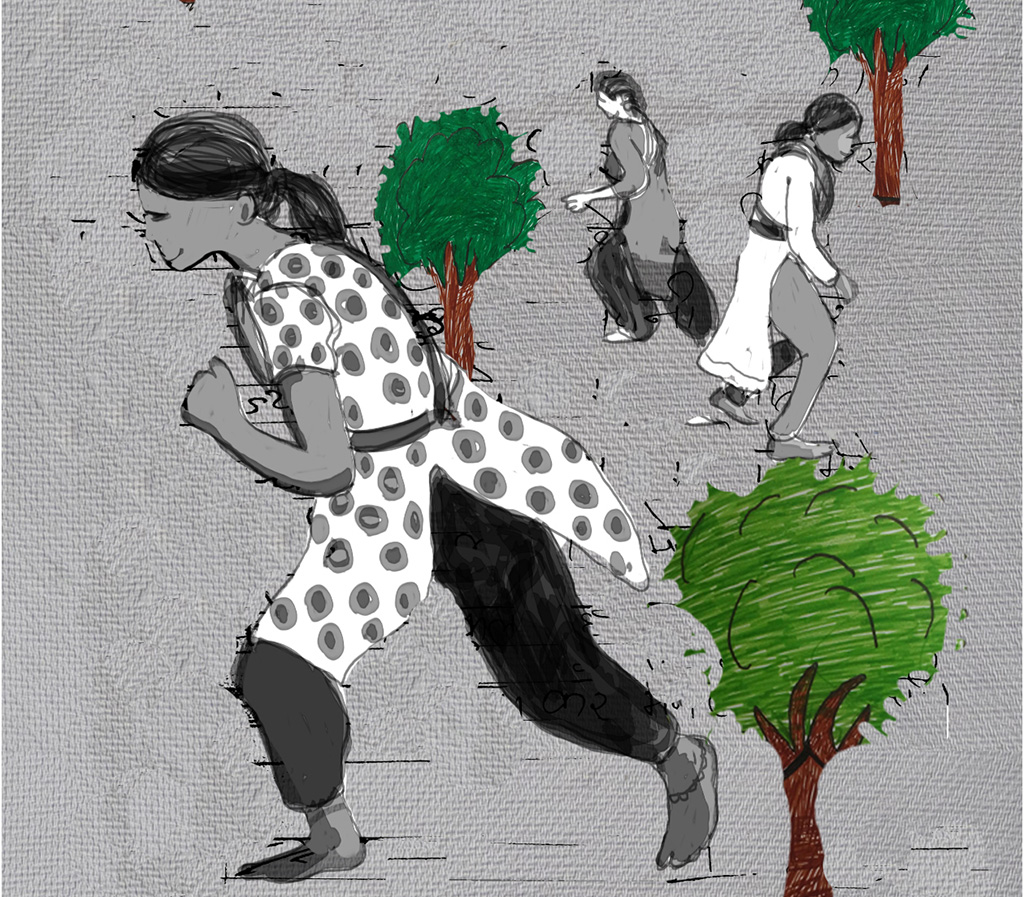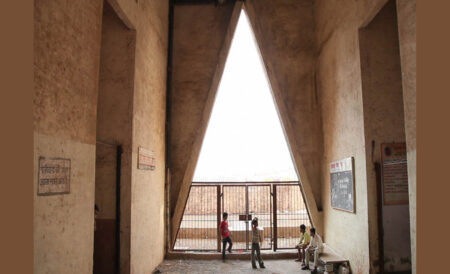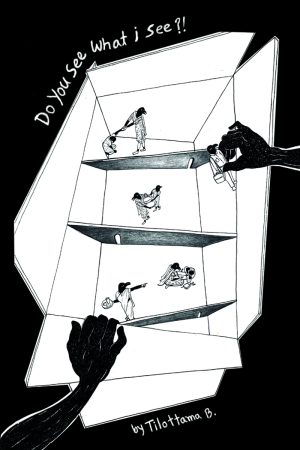We move like the wind.
Eight of us – four young teenage girls and four women – move about the room imagining ourselves in different places. Sometimes we are walking in open fields, sometimes we are catching the metro. Sometimes we are shrieking in glee and running through unexpected rain.
The four older women amongst us are facilitators associated with Nirantar’s PACE program. The younger women live in Trilokpuri and attend the centre to be able to finally answer their Class 8 or 10 examinations.
As we walk, we bring those imaginary environments to our room, or are transported there. Sometimes we are somewhere in between.
That is the first time the term ‘ched khaani’ (teasing) expands to hold not just the dangers of sexual harassment but also the utter pleasure of desire, flirtation and laughter.
Games we play
A woman’s journey into the city is much like a game of snakes and ladders. It has ladders of opportunities that lead to moments of ecstasy, followed by snake-like loops of endless negotiations around freedom. The metaphor of Snakes and Ladders seems perfect for my next workshop with the Third Eye Offline Fellows on the City and the borders and boundaries within it. It is a virtual workshop, this time round in September 2021.
If this workshop was to be conducted in a physical space, our game could be played on the floor. It would allow us to visualise each climb, each fall, and see how our bodies respond to each ladder and snake. Yet, the fact that the workshop was happening online was meaningful too; it reflected how our relationship and access to physical spaces have changed in the past two years. In the absence of physical spaces for finding ourselves, we’ve been forced to make do with our imagination and change only the spaces we occupy in our minds.
Maps of pleasure and danger
It is a reminder that our favourite space is not just about the physicality of place but also the liminality of what energies move and flow through them in time.
This theme repeats itself in mentions of melas that turn ordinary days into a storm of hustle and movement, and the ‘Saawan ka Mahina,’ the celebration of the approaching monsoons, with its swings and gushing rivers and all-round euphoria. The feeling of flow or fluid movement is present in some other favourite places – such as maidans, mountain top temples, gardens and open fields, where the flow of the wind finds special mention in why that place becomes special.
Another kind of flow I notice in the descriptions is around campuses, whether educational institutions or temples or places of art, where the flow of knowledge, ideas and spirituality create an environment of peace and joy. Finally, of course, are the descriptions of pure nature – forests through which women would have to walk through during their work in a faraway block, where they would take a few moments of leisure to sit and take in the forest.
What makes a place our favourite? Having fun, experiencing joy, feeling happiness and belonging? Can a physical place ever make us ecstatic? As I think about all the different states of mind that come to the surface when the participants describe their favourite places, I’m reminded of psychoanalyst Joyce McDougall’s idea of being ecstatic.
Building on Freud’s conception that the state of unpleasantness or mental pain comes from being blocked or dammed up, McDougall imagines ecstatic states as one that puts an end to that earlier state of stasis, of being blocked and in mental pain.
Snake-like boundaries and the ladders we use to cross them
Unfortunately for patriarchy, risk is the bedmate of that much more thrilling and life-affirming experience called adventure, and women across geography, history and social locations have had a particularly fond taste for life beyond the rigid boundaries built to keep them in.
Every day, millions of women fight invisible and unheard battles to break the dams and flow over the threshold into the outside world.
Crossing that first threshold is the hardest and can take the longest, just like the elusive six you roll in a game of Snakes and Ladders. It can take anything between just one try to some pleas whispered to the dice, some exasperated screaming after it lets one down before we can finally join the game – or in this case, enter the city!
In the workshop, I ask participants to map nine thresholds they have crossed or would like to cross, and identify the Snakes and Ladders that have been a part of their journey.
Even though I’ve asked for stories of mobility in the city, for my participants, it becomes a space to reflect and share life stories. The thresholds always start at home and mark a journey: desire to visit a new city, seeing new countries, or just being able to roam their own town, fearlessly. I get a sense that the term “upward mobility” could be seen not just in context of the class ladder, but for any movement that allows the possibility of seeing more of the world, and relating to it differently.
“We had moved from the city back to the village and I was not allowed to talk to anyone or get out of the house at all. At that time, going to school was my one ladder that allowed me to talk to the other girls in the village,” shares Khushi from Lucknow. While enough has been said about the value of education in girls’ lives, an important factor that often skips every articulation is the value of school as a social space where girls may access a world beyond the home. Yet, this element of joy and leisure does not escape the patriarchal gaze. “When I finished 8th Grade at the school in my village, my father said you’ve studied enough, there’s no longer need to study, you need to work at home,” Sudha from Banda narrates.
“We only had school in our village till Class 5, and to study ahead would require me to go to the next kasbah, and that distance was the snake to which I lost one year,” says Aarti from Lalitpur. Traveling a distance away from home feels like such a risk, that the ‘safety’ narrative makes girls drop out of school after 8th or 10th grade. Yet the deeper anxieties to do with travel, the possibility of seeing a new world, and meeting new people over whom there is lesser parental control are much more widespread, including in urban middle-class households, which value education and whose children are more likely to reap financial and social gains from it.
The ecstasy of stepping out of safety and into freedom
Listening to these stories, I’m taken back to such a moment in my own life, and realise what a lasting impact that first taste of freedom left on my psyche. In the summer after my 10th standard board exams, in between the protected boundaries of school and the promised open fields of junior college (as 11th- 12th grades are called in Mumbai), like every humanities-oriented, Kuch Kuch Hota Hai – influenced Mumbai teenager, I dreamt of going to St Xavier’s College in South Mumbai, about an hour away from my home in the suburbs.
My parents and I had reached an impasse, but for city parents like mine, it was easier to mask their anxieties behind logistical suggestions like the college nearby is “just as good” so why do all that exhausting travel. Yet, I knew that the nearby colleges meant peers and students from the same schools and conservative societies, unlike St Xavier’s which held promise of a whole new world with exposure to peers and progressive ideas from across the city.
The solution came in the form of a 3-day writing workshop on that side of the city. I decided to enrol for it as a trial run. While I had been to that part of the city many times before, this was the first time I would navigate the space all by myself. Equipped with bus routes and instructions, I woke up bright and early and arrived at the depot for my bus. Taking the bus from the first stop gave me the choice to sit wherever I wanted, and I sat on the right-hand side of the aisle, in the front where seats were reserved for women, next to the window.
I chose this spot because in my quick calculation of the route, I realised that the beautiful Haji Ali sea face would come to my right, and I was looking forward to watching it pass by. Equipped with my Walkman, the audio cassette of Shah Rukh Khan starrer Main Hoon Na, I rewound and replayed Chalein Jaise Hawayein Sanan Sanan, Udein Jaise Parinde Gagan Gagan, Jaayein Titliyan Jaise Chaman Chaman, Yun Hi Ghoomoo Main Bhi Magan Magan
(The way the winds blow, the way birds fly from sky to sky, the way butterflies jump from one flower to another, like them I too roam around immersed (in my joy).) As we hit Haji Ali, the sea breeze touched my face and in experiencing that all by myself without the gaze of a caretaker, I was ecstatic. That first feeling of freedom from “safety” left such a lasting impression in my mind, that I recently noticed that nearly 16 years later, I still always choose seats on the right-hand side of the aisle every time I take a flight, perhaps subconsciously trying to touch the experience of that first taste of ecstasy.
In my workshop, I hear so many versions of this story. Rajkumari talks about the lake in her village where her friends would go for a bath, but she was never allowed to. “When I started school, the route to and from school passed by the lake, and I would sit for a few moments of leisure or eat my meals,” she shares.
For others, ecstasy is pursuing their art, like singing is for Vaishali or dancing is for Anita, and for so many others it is simply being able to go to work in their respective organisations that act as ladders not just out of their homes and communities but also to new places, often big cities like Delhi.

Can the real snake please stand up?
Patriarchy’s “trust no one” motto is lodged firmly in her mind. Yet the attendant does no harm, and the rickshaw-walla takes good care of her and drops her to the right location. At the end of the trip, all she loses is her fear of travelling alone that the safety narrative had planted deep into her psyche.
Marriage uniquely appears as both a snake and a ladder in the stories that my participants share.
Two steps forward, one step back
At a physical workshop in Bhopal in 2021, a young disgruntled girl told the group, “If ‘they’ had it their way, they would never let us out of the house.” I saw this play out in front of me as each of my 10 participants, all below age 25, fought battles at home – with husbands or parents, to be allowed to attend that five-day workshop. One of my participants sneaked out of the house on the first day, while her husband was away, and spent the rest of the day in anxiety over what he would do once she returned home. The next morning she told us that he was angry and even hit her, but she came back anyway, the same way as she had the previous day, in the hope that someone from the NGO would go home with her to help negotiate with her husband. When she returned on the third day, she said her husband was now giving her the silent treatment. She didn’t return for the fourth and fifth day of the workshop.
Vikas, from my online The Third Eye workshop, says that the first threshold we need to cross is the one of our own mind, where fear holds us back from stepping out of our comfort zone and joining the flows of the world outside our own heads.
I remembered that in Bhopal, another young participant had sat quietly as she heard her peers talk about struggles within their homes and marriages. She smiled and looked engaged but passed every opportunity to speak. Then, on the third day of the workshop something amazing happened, as we all shared our reflections in the morning, she said, “Today I am going to speak. I have been thinking a lot about this, and I have decided that I have so many thoughts that I want to share so I am going to speak.” I was thrilled at the possibility of her crossing this first threshold, even as I could see that she has a long way to go before she could find the words to say all that she was feeling. Yet, it was enough for me to know she wanted to participate in the conversation. The next day, she didn’t show up for the workshop. “It’s just a logistical thing,” she reassured me on the phone, “I’ll be there tomorrow”. But I know that on the other end of the phone she was upset for not being able to come just when she had finally decided to share her mind. But true to her word she showed up the next day and as the workshop closed, they all broke into a dance that lasted for hours. In their otherwise dammed world, they’d found this small group where they could be a part of the flow, just as they were, and the energy of that could not be expressed in words but through bodies and movement and sounds and music.
The snakes and ladders of our mobility always leave us in a flux. Taste freedom, have it taken away, and redouble our efforts for it. Yet, those brief moments where we suddenly climb an unusually tall ladder or taste the sweet joy and pleasure of being a part of the flow of the world, infuse us with the strength and energy to continue pushing against boundaries.





